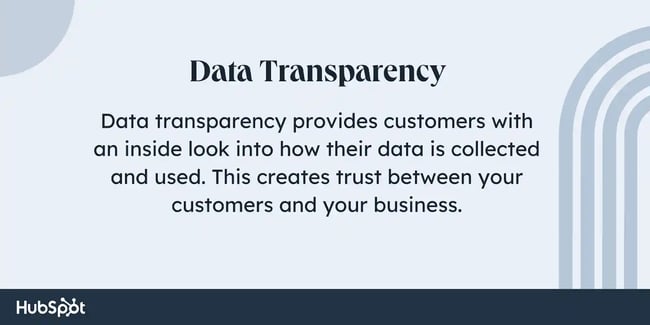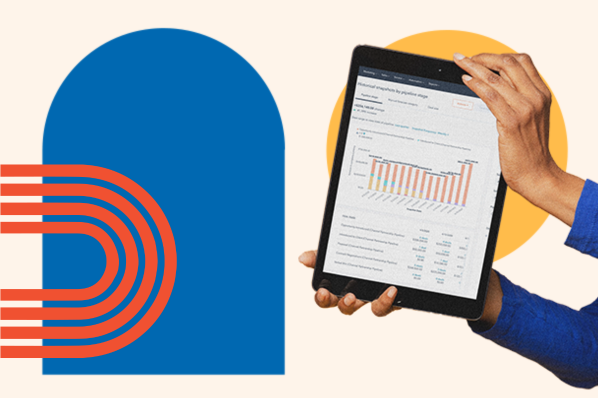In this post, you'll learn more about data transparency and best practices for keeping your customers in the loop about the usage of their data.
Table of Contents
- What is data transparency?
- Why is data transparency important?
- Who owns data transparency?
- Data Transparency Best Practices
- Data Transparency Examples
- Data Transparency Is Ongoing
What is data transparency?
Data transparency provides customers with an inside look into how their data is collected and used. This data usage must be ethical and within the confines of the law. With data transparency, customers should know why you need their data, how their information is gathered, where it is stored, and how it is protected.
Without this level of openness, it's near impossible for a customer to know who will have access to their information.

Why is data transparency important?
Many consumers have experienced misuse of their data. That may include security breaches that have leaked their information, credit card fraud, and identity theft. They know what's at stake when they hand over their data, leading to apprehension when sharing any personal information.
Data transparency can help re-establish trust. If you share how their data is used and how it benefits the customer experience, you can create rapport between consumers and your business. Potential customers can then decide whether or not the reward for sharing data is worth any risk.
Who owns data transparency?
When it comes to data transparency in an organization, there are typically three departments involved — the marketing department, the IT department, and the legal department.
Since data transparency is a large process with many moving parts, each team has its own responsibilities. For example, a digital marketer or marketing researcher usually identifies what type of information needs to be collected to improve customer experience.
Once they have identified the important data points, a member of the company's legal counsel will often step in next to determine any potential issues that need to be addressed. After the legal department approves the data-gathering process, the IT team decides the best way to collect, manage, and store the data.
Several data quality managers, analysts, and engineers will often work together to form a data management team inside the IT department.
Data Transparency Best Practices
As customers become more protective of their data, you'll need to master transparency. Below are three best practices you can implement to help foster trust between your company and customers.
1. Be open about how data is collected and used.
We've all been there before. One minute, we're researching a new shampoo that we're looking to buy, and, five minutes later, an ad pops up for that same shampoo.
While some people don't mind the customized marketing approach, many consumers are becoming concerned about how much data is being collected online.
By disclosing to website visitors the type of data you collect and how it will be used, you provide them with the transparency needed to build trust. This also provides an opportunity to incentivize consumers to share information. Offering a discount, service, or product in exchange for information can be a great way to gain data and a new customer.

2. Build internal processes around data management.
Consistency is key when it comes to successfully managing data transparency. Having internal processes in place for how data will be collected, stored, and used will help reduce the chances of information being lost or corrupted.
Remember to continuously review and improve current processes. Laws and regulations often change how businesses can use personal data.
3. Don't collect more data than you need.
The phrase "more is less" perfectly describes data. While many companies are under the preconceived notion that the more data they have, the more they will be able to market to potential customers, that isn't always the case.
Collecting less data can be more advantageous than collecting a wide range of information. For example, identifying key data points makes it possible to quickly create a unique experience for each consumer while using less storage and keeping analysis costs low.
Data Transparency Examples
Establishing data transparency processes and best practices is often tricky if your organization is just starting to dip its foot into the world of data. To help inspire your organization, here's a closer look at how some of the biggest brands are utilizing data transparency today.
1. The Guardian
As one of the most-read newspapers in the United Kingdom, The Guardian is a large consumer and collector of personal information. However, the organization has always had a reputation for being trustworthy. One of the ways they were able to achieve this was by utilizing digital transparency.
Instead of a typical privacy agreement, The Guardian created a video highlighting how information was collected, utilized, and stored.
What we like: The Guardian understood that while a privacy policy is useful, most consumers won't take the time to read the entirety of it. So instead, they created a video that is just under one minute and thirty seconds long. The video highlights everything consumers need to know about their data management practices.
2. Slack
Slack also found a way to make data transparency engaging for consumers. Instead of a video, they decided to provide an easily digestible privacy policy that explains the inner workings of their data management process.
Here's a snippet from their privacy principles.

What we like: While many organizations are worried about putting together a privacy policy that is long and covers everything, Slack decided to pare theirs down and offer an easy-to-read version.
3. Zoho
Zoho is one of the few companies that have taken a completely different approach to their clients' information. Unlike other businesses that collect data through traditional trackers and sell it to other organizations, Zoho has repeatedly stated that it will not. Instead, they have committed to their customers that they are more important than data collection.

What we like: Zoho has taken data transparency to a new level by openly promising not to collect and distribute personal information to other organizations. This decision makes Zoho stand out among the competition and could be a valuable selling proposition for customers concerned about their personal information.
Data Transparency Is Ongoing
Remember: data transparency is an ongoing process. This transparency shouldn't just stop at the initial request stage — having data transparency throughout the entire relationship is equally important.
If new processes expose data to different parts of your organization, or a customer's data will be used for purposes other than what they initially agreed to, they should be made aware of it. This level of transparency helps define a company as a trustworthy organization.
CDP





![Customer Data Integration: A Complete Guide [Expert Tips & Examples]](https://53.fs1.hubspotusercontent-na1.net/hubfs/53/customer-data-integration-1-20241218-9529716.webp)






![What Is an Identity Graph? [The Plain-English Guide]](https://53.fs1.hubspotusercontent-na1.net/hubfs/53/identity-graphs.jpg)